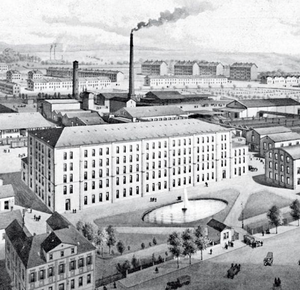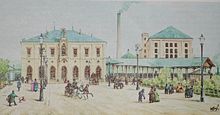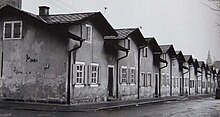Mechanical cotton spinning mill Bayreuth
The mechanical cotton spinning mill was one of the three large spinning companies in Bayreuth , Bavaria.
prehistory
Founder of the factory was from Augsburg coming Ludwig August Riedinger (1809-1879). As the main shareholder, he brought 125,000 guilders (fl) into the company and moved u. a. Alexander Friedrich Wilhelm von Württemberg to participate with large amounts. Factory owners and merchants were followed by the mayor Friedrich Carl Dilchert , senior officials, officers, doctors and pharmacists. Finally, “little people” also signed the list of shareholders, and what was popularly known as “mechanical” spinning became a “matter for the whole city”.
location
The site of the spinning mill was immediately to the east of the main train station . Originally located north of Markgrafenallee, the business spread across the street to the south. The weaving mill , which opened in 1886, was located north of Hammerstrasse (since 1947 Friedrich-Ebert-Strasse). Residential buildings for workers and employees were built in this area from the turn of the century and formed the nucleus of the Hammerstatt district . From the nearby train station, a siding led along the northwest side of the main building.
history
On October 30, 1853, the Mech. Cotton spinning mill in Bayreuth was founded with a capital of 1,038,000 fl. 519 shares at 1,000 fl. And 1,038 shares at 500 fl. Soon after the station opened on November 28, 1853, construction of the facility began in 1854 , immediately after the notarized property purchase. The five-and-a-half-story factory building was completed in just under seven months. With towers and battlements, the 86 meter long and 24 meter wide building resembled a fortress, it was one of the tallest industrial stone buildings in the Kingdom of Bavaria . On November 8, 1855, a steam engine supplied by Maschinenbau-AG Nürnberg was heated for the first time and the spinning machines started up . At the end of December of that year, operations with 29,288 spindles were opened.
The working day lasted from 5 a.m. to 7 p.m., with a quarter-hour break at 7.30 a.m. and an hour-long break at 12 noon. The hourly wages of the workers were 2 kreuzers , qualified specialists received 2½ kreuzers. It took about six hours to work a pound of meat, four hours for a liter of beer and at least half an hour for a bun. There was no vacation, and health and social insurance did not initially exist. In 1857 factory workers of the “Mechanische” collected twenty guilders for the victims of a fire disaster.
In 1877 a second spinning mill (shed spinning mill) with 20,000 spindles was built, and in 1881 the capital was set at 1,660,000 marks . In 1886 a weaving mill was added to the business and the company name changed to Mech. Cotton Spinning and Weaving Bayreuth . In 1860 it had 620 employees, in 1935 the number had grown to 1,440, with 1,450 it reached its highest level in 1940. The number of spindles, the measure of the size of a spinning mill, was 100,000 in 1940.
The "Mechanische" was ahead of its time with its spectacular social benefits at the time. In 1861 she built the first Bavarian social housing estate in the neighboring district of Burg . In addition, it offered inexpensive food and clothing, from the 1870s had its own dining houses, a works library, a sewing and knitting school and even a kindergarten (toddler school). The company's pension fund and the company's health insurance, which reimbursed lost wages as well as medical and pharmaceutical costs for a certain period of time, were also exemplary since 1856. From 1862 onwards, the wives and children of the employees also received free medical and medicinal help.
On January 13, 1941, Bayreuth was the target of a first bomb attack by the Royal Air Force . One or two multi-engine aircraft flew low over the city's three spinning mills between 3.17 a.m. and 4.56 a.m. Two flare bombs , three explosive bombs and around 33 incendiary bombs were dropped from a height of 200-300 m . The mechanical cotton spinning mill was hit hardest, the cotton stocks of which were completely destroyed. People were not injured, although the fire fighting teams were repeatedly exposed to machine gun fire due to the lack of flak units . The damage amounted to around 450,000 Reichsmarks , and production was suspended for about a month from January 18.
In 1942 the "Mechanische" was supposed to be shut down, but this could initially be prevented. In October 1943, the armaments minister Albert Speer confiscated the factory for the armaments industry. The United Ball Bearing Factory in Schweinfurt could no longer produce due to the destruction caused by Allied bombing . However, a manufacturing unit could be salvaged and made operational again. From December 1943 it was relocated to Bayreuth in the mechanical cotton spinning mill. In addition, cotton processing was continued. In the spring of 1945 100,000 spindles and 1,800 looms were still in use, 1,450 people were employed in the business.
For ninety years the gigantic factory building was one of the city's landmarks. After about a third of the facility had already been destroyed in the bombing of the station on April 5, 1945, the main building was largely destroyed in the heaviest bombing raid on Bayreuth on April 11; only part of the outer walls remained. In 1947/48 the ruins, popularly known as " Heidelberg Castle " because of their appearance , were blown up.
In the undamaged branch in nearby Friedrichsthal , production began again in July 1945, and from late autumn 1949 onwards in the newly constructed building in the city. In the course of the economic miracle of the post-war period , the number of one thousand employees was reached again in 1959.
The local textile industry with its three large companies was hit hard by the economic crisis of 1974/75. The "Mechanische" sold land and the Burg social housing estate, but could not avert the opening of a settlement procedure on May 18, 1981. The spinning mill was sold and the weaving mill continued under a new name. This company (SR Webatex GmbH) has been part of Getzner Textil Aktiengesellschaft since 2016 .
A relic from the early days of the “mechanical” is their preserved water tower.
literature
- Bernd Mayer: Mighty leap into the industrial age . In: Heimat Kurier . No. 4 , 2003, p. 6-7 .
- Herbert Popp: Bayreuth - rediscovered . Ellwanger, Bayreuth 2007, ISBN 978-3-925361-60-9 .
Individual evidence
- ↑ Bernd Mayer : Mighty leap into the industrial age in the home courier des Nordbayerischer Kurier 4/2003, p. 6.
- ^ The Bw Bayreuth , loose-leaf collection of GeraNova Verlag Munich, p. 26.
- ↑ a b c d Mechanical cotton spinning and weaving in Bayreuth at albert-gieseler.de, accessed on November 18, 2018
- ^ A b c Rainer Trübsbach: History of the City of Bayreuth 1194–1994. Druckhaus Bayreuth 1993, ISBN 3-922808-35-2 , p. 192.
- ↑ a b c d Bernd Mayer: Bayreuth as it was. Flash lights from the city's history 1850–1950 . 2nd Edition. Gondrom, Bayreuth 1981, p. 20 .
- ↑ Bernd and Gerda Mayer: Work and live in Bayreuth . Sutton, Erfurt 2010, ISBN 978-3-86680-745-7 , p. 33 .
- ↑ Christoph Kuhl: Air protection and aerial warfare in Upper Franconia 1933-1945 . In: Historischer Verein für Oberfranken (Hrsg.): Archive for the history of Upper Franconia 88th volume . Ellwanger, 2008, ISSN 0066-6335 , p. 347 .
- ↑ Bernd Mayer, Helmut Paulus: A city is denazified. The Gau capital Bayreuth in front of the Spruchkammer . Ellwanger, Bayreuth 2008, ISBN 978-3-925361-67-8 , pp. 187 .
- ↑ a b The mysterious air raid in: Nordbayerischer Kurier of April 7, 2020, p. 9.
- ↑ Bernd Mayer: Bayreuth April 1945 . 1st edition. Wartberg, Gudensberg-Gleichen 2004, ISBN 3-8313-1463-2 , p. 44 .
- ↑ https://www.wer-zu-wem.de/firma/sr-webatex.html SR Webatex bei habenzu-wem.de, accessed on July 10, 2020
Coordinates: 49 ° 57 ′ 0.6 ″ N , 11 ° 34 ′ 54.3 ″ E






